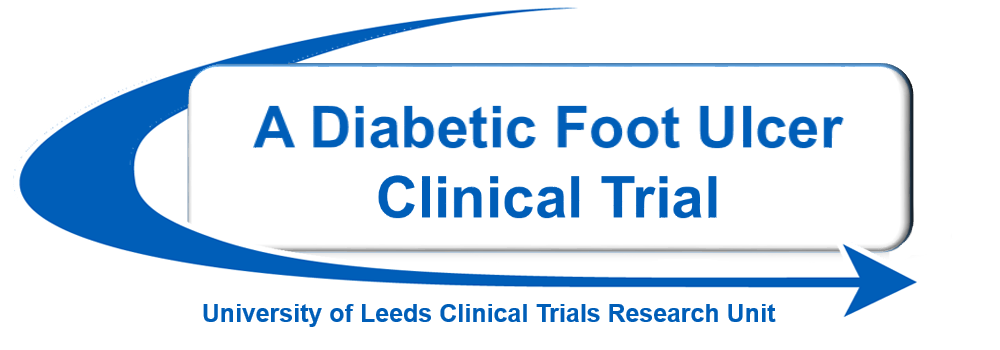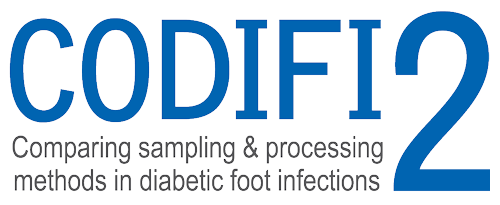More Information
FAQ
Up to 1 in 4 people with diabetes will develop a foot ulcer. Some ulcers become infected with bacteria, which can delay healing and damage the skin and bone in the foot.
When infection is suspected the clinician will collect a sample from the wound to send to a laboratory to identify the bacteria causing the infection. There are two ways to collect a wound sample:
1. Collecting wound fluid using a cotton swab called wound swabbing
2. Taking a small piece of wound tissue from the wound called tissue sampling
Wound swabbing is easier and is used more often but tissue sampling can collect more bacteria.
CODIFI2 will test whether having more bacteria from a tissue sample helps doctors make better decisions about antibiotic treatment, and if this helps cure the infection and helps the ulcers heal more quickly.
To make a fair comparison between swabbing and tissue sampling we are recruiting patients with a diabetic foot ulcer with suspected infection. Half of those recruited will have wound swabbing and the other half will have tissue sampling.
We will also compare two different laboratory tests; one method that grows the bacteria in the laboratory and one method that looks for the DNA of bacteria (each type has a different genetic fingerprint).
This will help us see whether a DNA method provides the same or different information than the routine laboratory growth method and if this information could change clinical treatment e.g. antibiotic.
Detailed information about the trail can be found in the video below:
Participants are recruited from participating foot clinic recruiting centres. Please explore the recruiting sites tab on the CODIFI2 website to see if your site is listed.
If you are attending one of these recruiting foot clinics and your clinician suspects you have an infected foot ulcer, you are over the age of 18 and have diabetes you may be eligible to take part in the trial.
There are broadly 3 aspects to this trial (1) Wound sampling, (2) Photographs of your wound and (3) Questionnaires these are detailed below:
1. Sampling
During your appointment at the clinic a sample from your wound will be taken. This will either be a wound swab or tissue sample. One extra sample will also be taken for DNA testing at this first appointment only.
If during the treatment of your wound, more samples are needed from your wound then this will be same sample method for the duration of the study, for example:
• If you received the tissue sampling method then any further samples to look for infection would be a tissue sample.
• If you received the wound swabbing method then any further samples to look for infection would be a wound swab.
All samples will be sent to the laboratory as normal. No other aspect of your treatment will be affected.
2. Photographs
To monitor how well your wound is healing we will need to take photographs or your wound. This will happen at the start of the trial, 4 weeks into the trial and when it has healed. Photographs will only be taken of your wound and you will not be identified from any of the pictures.
3. Questionnaires
At some of the visits to the clinic you will be asked to complete 2 short questionnaires. These will ask questions about your wound and your health. If you do not wish to answer any of the questions you do not have to.
You will also receive questionnaires in the post to complete, these will include a stamped addressed envelope to send the questionnaire back to us.
Information about what will happen during the trial can found in the video below:
Please explore the recruiting sites tab on the CODIFI2 website to see if your site is listed.
A previous trial called CODIFI (Concordance in Diabetic Foot Infections) comparing swab and tissue sampling, found that tissue sampling collects more bacteria than swabbing. The CODIFI2 study follows on from the first CODIFI study hence the ‘2’ and aims to test whether collecting more bacteria using a tissue sample helps doctors make better decisions about which antibiotics to use.
We know laboratory results from wound samples help doctors make decisions about which antibiotic to use. We would like to find out whether a swab or tissue provides the most useful information for doctors to make treatment decisions and if a faster bacterial DNA test would also help.
The results of this study should allow us to provide recommendations for the most appropriate sampling method to be used by doctors which will aid their treatment decisions
Participation in this study will help to answer this question and help us to improve the treatment of diabetic foot ulcers in the future and ultimately benefit other patients.
The method used to obtain the tissue sample requires scraping of the ulcer which may lead to a small amount of bleeding and some discomfort may be felt by patients. This will be managed by your clinical team.
We are also asking you to give up some of your time to take part. Wherever possible your research appointments will be made at the same time as your usual clinic appointment. However, you may be asked to attend an extra visit (for example if your wound has healed to confirm healing) and your travel expenses will be paid if you need to come to the clinic for a visit which you would not normally have to attend as part of your routine care.
Once you have finished taking part in the study, you will continue to be looked after by the diabetic foot ulcer clinic and community team (where required) as normal.
When the study is complete the results will be published in a medical journal, but no individual participants will be identified. These will be made available on this website.
If you withdraw from the study, the information already collected on you will remain on file and will be included in the final study analysis. In line with Good Clinical Practice guidelines, at the end of the study, your data will be securely archived for a minimum of 5 years. Arrangements for confidential destruction will then be made.
If you withdraw consent for your information to be used it will be confidentially destroyed.
Yes. If you decide to participate in CODIFI-2 the information collected about you will be handled in accordance with the consent that you have given and also the 2018 Data Protection Act.
Your GP and the other healthcare professionals involved in your care will be kept informed of your participation in this study. A letter will be sent to your GP (subject to your agreement) to let them know you are taking part and to ask them to let the study team know if your ulcer has healed, a healed ulcer has re-opened or if you develop a new ulcer.



